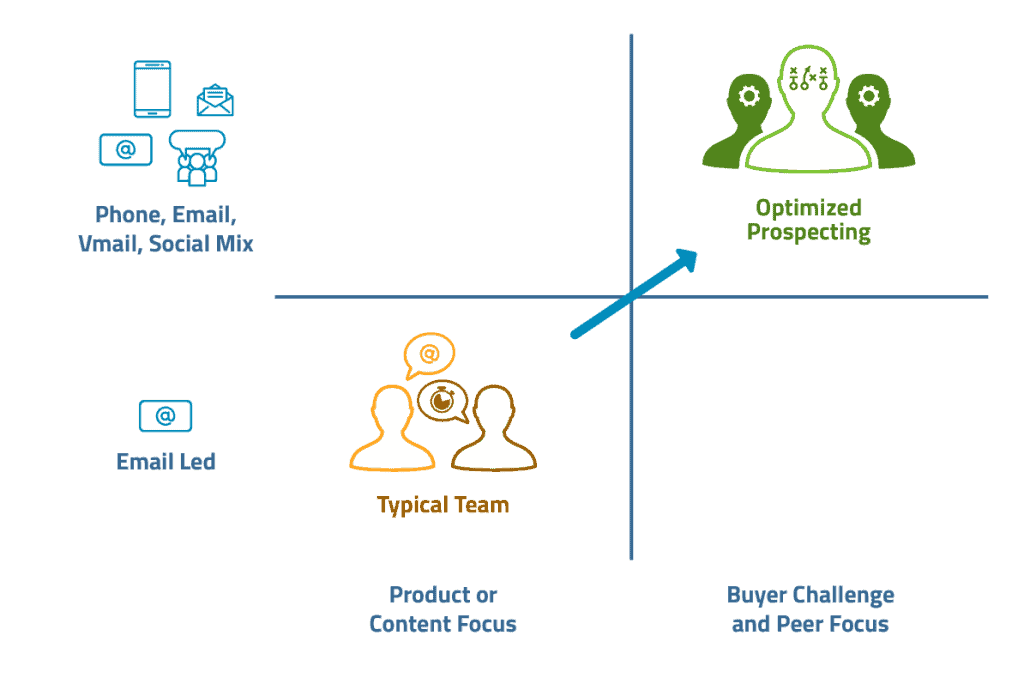Sales teams make two big mistakes in their prospecting work. First, in their messaging they rely too heavily on product pitching, content and attention grabbers that lead to an information blur and cause prospects to check out. Second, in their outreach approach, they rely too heavily on high volume email sequences, forgetting that the quickest path to getting a prospect to take a meeting is phone outreach.
A much more effective alternative is to prospect as a trusted advisor. The trusted advisor works to make a strong first impression that your company’s goal is to address challenges, solve problems and provide value in early discovery.

Why “Spray and Pray” Content Disengages Prospects
Too much generic content is a key way we cause our prospects to disengage. A recent article by Medium.com showed the extent to which this kind of content marketing is overwhelming potential buyers: more than 91% of companies use content marketing but fewer than 30% tailor content to the buyer journey or persona.
A second type of content that causes buyer disengagement is outreach heavy on product and functionality. When our prospecting outreach leads with product and feature dumping, buyers quickly conclude that any discovery call will just be more of the same and may choose not to engage.
A final cause of buyer disengagement are “attention grabbers” like “free”, “act now”, “don’t miss this.” All of these approaches signal to the prospect that we have already decided on a course of action in an initial discovery call and do not need to listen or let them guide the flow of the conversation.
Providing Value in Early Discovery
In a noisy buyer market, you have the best chance of breaking through by making it very clear that you plan to provide your buyers with a ton of value early in their discovery process.
To do this, embrace these four main principles for inviting prospects into a value-added conversation:
- Lead with a buyer challenge: Use your prospecting touch sequences to tell a story about why a buyer might want to speak with you. The touch sequence should start with a common buyer problem, continues with proof that you solve that problem, and then outlines goals for a short intro call including benefits on both sides
- Demonstrate your expertise: One or two content marketing pieces are quite valuable in a touch sequence when they demonstrate expertise in solving the buyer’s challenge. You can share quick snippets on your unique capabilities, peer success stories, names of peers you already helped, company blogs or research that validate the impact of your capabilities.
- Keep emails brief and engaging: Hubspot has shown 75-125 word emails that include 1-3 questions do much better than a pitch at drawing prospects into a response. Short and to-the-point messages indicate respect for a prospect’s time and questions invite a conversation.
- Say hello and goodbye: You will get the most meetings by committing to 8-9 email, voicemail, and call touches across 3 to 4 weeks. However, regardless of the number of touches, you can build trust by starting with a “hello email” telling the buyer why you want to speak to them and ending with a “goodbye email” acknowledging that if now is not a good time to talk, you will reach back later
Phone-Led, Mixed Prospecting
Many sales teams prefer email blasts with a high volume of content marketing. This is, in part, because email is viewed as more “more efficient.” It is also because, as shown in this recent HBR article, 48% of B2B sellers are afraid of getting on the phone and 60% are inconsistent in their prospecting.
However, in a complex buying environment the phone is king in driving new meetings. A study by Salesforce found that phone-based outreach delivered a 8.21% response rate compared to .03% response for email, making phone outreach 274 times more effective.
There are few reasons that phone-led prospecting supported by a mix of email, voicemail, and social media touches outperforms email-led prospecting:
- Live call connects, where we catch a prospect or the prospect’s assistant live on the phone, are a great way to communicate our value proposition and build rapport which in turn increase the chances of converting to a 1st call.
- Voicemails with a live voice set you immediately apart from the blizzard of email spam and allow you to call specific attention to an email that otherwise would be ignored.
- Peer or success case referencing has a lot more meaning when you can put 15 seconds of detail in a voicemail. That same 15 seconds might take 40 words in an email, making it too long for many prospects to bother reading.
Prospecting as Trusted Advisor: A Simple Self-Diagnostic
Here are a few questions you can ask yourself as you think about marking the transition from product- or content-led prospect outreach to prospecting as a trusted advisor:
- Does your outreach messaging focus on specific challenges or pains by buyer persona?
- Do you script out 8+ call, email, voicemail, social touches that follow a value narrative?
- Do you provide prospectors with targeted discovery questions focussed on buyer goals to quickly build interest? And client names by segment so they can quickly build reference value?
- Do you reinforce and build consistency in best prospecting practice across the team?
Adopting a consistent team-wide approach to value-added prospecting pays dividends in better discovery, more 1st meetings and higher prospect engagement throughout the buying cycle.
